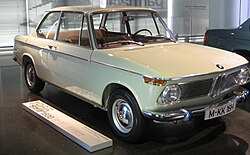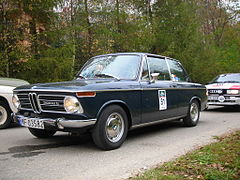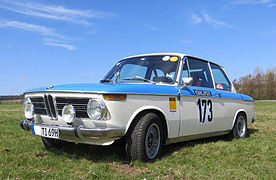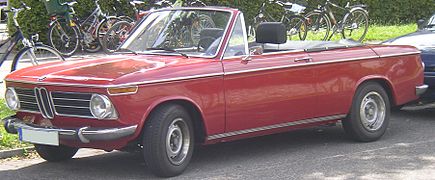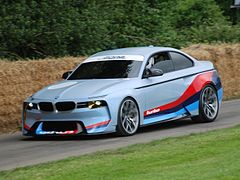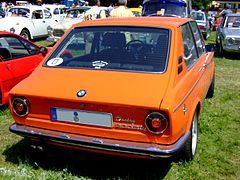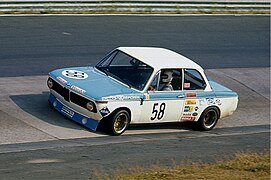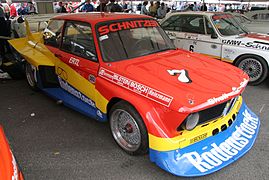BMW 02
| BMW | |
|---|---|
|
BMW 1600 (1966–1971)
|
|
| Type 114, E6, E10, E20 | |
| Production period: | 1966-1977 |
| Class : | Middle class |
| Body versions : | Sedan , station wagon , convertible |
| Engines: |
Petrol engines : 1.6–2.0 liters (55–125 kW) |
| Length: | 4220-4230 mm |
| Width: | 1590-1620 mm |
| Height: | 1360-1410 mm |
| Wheelbase : | 2500 mm |
| Empty weight : | 940-1080 kg |
| successor | BMW E21 |
The original 114 series, also known as the 02 series, comprised mid-range vehicles produced by BMW between April 1966 and July 1977. The 02 series rounded off the BMW range at the bottom. It was derived from the New Class 1600 model , but the vehicles were designed as two-door .
There were only four-cylinder models (engine type M10 ) with the designations 1502, 1600-2, 1602, 1600 TI, 1802 as well as 2002, 2002 ti, 2002 tii and 2002 turbo. The first two digits indicate the displacement, except for the 1502, which had a 1.6-liter engine. The development codes are type 114 for the 1502–1802 models, E6 for the touring models, E10 for the 2002 including TI and tii and E20 for the 2002 turbo.
The series was replaced in August 1975 by the first BMW 3 Series ( E21 series ), with the smallest model 1502 still being produced until July 1977.
BMW 1502, 1600-2, 1802, 2002
The 1600-2 was presented at the Geneva Motor Show in March 1966. Its unofficial name tag "-2" was only intended to identify the 1600 as the new two-door model from BMW and help differentiate it from the larger four-door sedan ; on the vehicle itself, the model name was only "1600". The first variant of the particularly successful 2002 with a displacement of around 2 liters (see table of model overview) went into series production at the beginning of 1968.
Model maintenance
With the facelift in February 1971, the 1600 (-2) was referred to as 1602. All cars received bumpers with rubber pads that were drawn around the rear and a bumper strip all around. The now two-part dashboard was completely black and the seats and fittings were also changed. Another variant was the 1802 with 66 kW (90 hp).
From August 1973, the vehicles were given a black plastic grille , a flatter kidney grille , perforated steel disc wheels without hubcaps and (with the exception of the Touring) larger, angular rear lights.
At the beginning of 1975, the 1502, designed as a “savings model” with simplified equipment, appeared . It had the engine of the 1602, which now with different pistons and lower compression achieved a maximum output of 10 hp less than the 1602, but could be driven on regular gasoline. The most important external distinguishing feature of the 1502 compared to the higher versions was the lack of a surrounding decorative strip. Furthermore, certain equipment elements such as the front vent windows or five-inch-wide perforated disc wheels were subject to a surcharge on the 1502.
BMW 1600 ti, 2002 ti, 2002 tii
The abbreviations "ti" (Turismo Internazionale) or "tii" (Turismo Internazionale Iniezione or "Injection") designate the more powerful versions of the M10 engine in the BMW 02. There were three variants:
- The first model appeared in the summer of 1967, the 1600 ti, which rolled off the assembly line by the end of 1968. Its 1.6-liter engine developed 105 hp (77 kW).
- The 2002 ti had a 120 hp (88 kW) engine with a displacement of two liters. It was published in mid-1968 and remained in the program until spring 1972.
- The last stage of evolution was the 2002 tii introduced in spring 1971. Its engine also developed 130 hp (96 kW) from a displacement of two liters.
The ti models have 40 Solex - dual carburetors , 2002 tii and 2002 turbo have an engine with mechanical ball Fischer-fuel injection , as at that time even when Peugeot was used or in racing was used, there but usually in conjunction with a Einzeldrossel- or flat slide system instead of the standard throttle valve.
M10 engine of the 2002 tii with Kugelfischer injection
BMW 2002 turbo
The model developed under the code BMW E20 with a maximum engine output of 170 hp (125 kW) was (even before the Porsche 911 Turbo ) the first mass-produced German car with an exhaust gas turbocharger .
The BMW 2002 turbo , which was presented in the autumn of 1973 in the middle of the first oil crisis , was immediately criticized in public for its high fuel consumption, as well as for the turbo 2002 lettering , which the press dubbed "war paint", on the front spoiler in mirror writing has been. A rear spoiler was also part of the equipment.
From September 1973 to November 1974, 1,672 vehicles were produced, which were only available ex works in the BMW colors Polaris metallic (silver) and Chamonix (white). In today's purchasing power and currency, the price of 20,780 DM demanded at the end of production in 1974 currently corresponds to a total of 29,500 euros.
BMW 1600 Cabriolet, 1600-2 Baur Cabriolet, 2002 Baur Cabriolet
The completely open BMW-1600-Cabriolet (type BMW 114 C) was designed by Baur in Stuttgart for BMW and built there from the beginning of 1968 to autumn 1971.
There were two convertible versions of the 02: a full convertible and a convertible with roll bar, also known as a Targa. The cabriolet was available as the 1600-2 with a 1.6-liter engine 63 kW (85 PS) and as the 2002 with a two-liter engine and 74 kW (100 PS).
The torsion-resistant cabriolet with roll bar or Targa was only available for the 2002; it was offered from autumn 1971 to summer 1975.
In March 2018 at the Retro Classics in Stuttgart, the Augsburg company Everytimer presented an 02 convertible based on the 1 Series BMW, see also the section with homage for pictures.
02 (turbo) homage and 02 retro convertible
As in the previous year with the BMW 3.0 CSL Hommage , BMW presented the 02 Hommage at the Concorso d'Eleganza on Lake Como in 2016. This quotes the simple round headlights and the mirror-inverted turbo lettering on the front spoiler.
In March 2018 at the Retro Classics in Stuttgart, the Augsburg company Everytimer presented an 02 convertible based on the 1 Series BMW E88 .
Everytimer ETA 02 Cabrio at the Retro Classics 2019
BMW Touring
From spring 1971 there were also hatchback variants with all engines with the exception of the 1502 and 2002 turbo with the names BMW touring 1600 , touring 1800 , touring 2000 and the top model, the touring 2000 tii .
Facelift
With the facelift in August 1973, the model designation changed, the designation touring was no longer placed in front and the type designation was appended with the 2 , which is already common with the sedan , so the touring 1800 became the 1802 touring , the touring 2000 became the 2002 touring and from the touring 2000 tii to the 2002 tii touring . The basic model touring 1600 with the 1.6 liter engine with 63 kW had already been deleted at the beginning of 1972.
The touring model was not a sales success, as only 25,827 units were produced from spring 1971 to summer 1974. Only 20 years later, BMW offered a hatchback model again with the 3 Series Compact .
BMW 2002 ti Diana
A very rare variant is the so-called 02 Diana . On the occasion of his wedding to Diana Körner in 1970, racing driver Hubert Hahne had twelve 2002 ti rebuilt, as it were as a wedding present - among other things with double headlights of the BMW 2800 CS , leather interior, special Italian aluminum wheels. Each of the twelve copies was painted in a different color.
Over the years, the whereabouts of most copies of this small series could no longer be clarified - it can be assumed that some owners of one of these copies believe they are driving a simply converted 02 without realizing that they have one of the rarest 02s their own (Verification of the chassis numbers on the website of the BMW 02 Club e.V., see web links).
At the moment four surviving Diana are known, including a Diana Cappuccino.
BMW 1602 electric
BMW developed the 1602 Elektro for the 1972 Summer Olympics . Development began in 1969 with two test vehicles. For test purposes, they served as an escort vehicle for long-distance walkers and marathon runners during the games. The energy store consisted of a package weighing 350 kilograms with twelve lead starter batteries under the bonnet, which could be exchanged for a package of charged batteries. This allowed you to drive about 60 kilometers at a constant 50 km / h, in city traffic it was about 30 kilometers. The maximum speed was 100 km / h and the acceleration from 0–50 km / h took 8 seconds.
Sporting successes
The 02 series cars were very successful in racing , especially on the circuit in the German racing championship , but also in rallies , hill climbs and slalom . The series formed the starting point for a number of tuning companies such as Alpina , Schnitzer , Koepchen , GS-Tuning , etc., which contributed to making the 02 series even sportier on the racetrack and on the road. 16-valve cylinder heads on the M10 from Formula 2 (BMW) or a cylinder head specially developed by Schnitzer for this purpose (which was also used in part by Alpina and GS-Tuning), as well as turbo , were used in racing at times -Engines that later led to the 2002 turbo. To this day, some of the vehicles are driven in a sporty manner and used with success at motor sport events such as circuit races , rallies or hill climbs.
Helmut Kelleners 1973 in a Koepchen-BMW 2002 on the Nürburgring
BMW 2002 TI rally at the Goodwood Festival of Speed 2006
BMW 02 with Schnitzer 16V cylinder head (based on BMW M10 )
Model overview
| Vehicle type: | BMW 1502 | BMW 1600 (-2) | BMW 1602 | BMW 1600 ti | BMW 1802 | BMW 2002 | BMW 2002 ti | BMW 2002 tii | BMW 2002 turbo |
|---|---|---|---|---|---|---|---|---|---|
| Construction time: | 01 / 1975-07 / 1977 | 04 / 1966-02 / 1971 | 02 / 1971-07 / 1975 | 09 / 1967-11 / 1968 | 02 / 1971-07 / 1975 | 02 / 1968-07 / 1975 | 06 / 1968-04 / 1972 | 05 / 1971-07 / 1975 | 09/1973-11 / 1974 |
| Engine : | Four-cylinder four- stroke in - line engine ( BMW M10 ), water-cooled; V-shaped hanging valves, controlled by an overhead, chain-driven camshaft via rocker arms; Aluminum cylinder head ; Five-bearing crankshaft | ||||||||
| Displacement : | 1573 cc | 1766 cc | 1990 cc | ||||||
| Bore × stroke: | 84 mm × 71 mm | 89 mm × 71 mm | 89 mm × 80 mm | ||||||
|
Carburettor / mixture preparation : |
1 downdraft carburetor Solex 38 PDSI with accelerator pump and choke | 1 downdraft carburetor Solex 38 PDSI with accelerator pump and choke | 2 Solex flat-flow double carburetors 40 PHH | 1 downdraft carburetor Solex 38 PDSI | 1 downdraft carburetor Solex 40 PDSI | 2 Solex flat-flow double carburetors 40 PHH | Petrol injection Kugelfischer PL 04 | Gasoline injection Kugelfischer PL 04 with turbocharger type BLD from KKK ( Kühnle, Kopp & Kausch ) | |
| Compression : | 8: 1 | 8.6: 1 | 9.5: 1 | 8.6: 1 | 8.5: 1 | 9.3: 1 | 10: 1 (from 9/72: 9.5: 1) | 6.9: 1 | |
| Performance at 1 / min: | 55 kW (75 PS) at 5800 | 63 kW (85 PS) at 5700 | 77 kW (105 PS) at 6000 | 66 kW (90 PS) at 5250 | 74 kW (100 PS) at 5500 | 88 kW (120 PS) at 5500 | 96 kW (130 PS) at 5800 | 125 kW (170 hp) at 5800 | |
| Torque at 1 / min: | 117.5 N m (12 kp m ) at 3700 | 123.5 N m (12.6 kgf) at 3000 | 131.5 N m (13.4 kgf) at 4500 | 143 N m (14.6 kgf) at 3000 | 157 Nm (16 kgfm) at 3000 | 166.5 N m (17 kgf) at 3600 | 176.5 Nm (18 kgfm) at 4000-4700 | 240 N m (24.5 kgf) at 4000 | |
| Gearbox (standard): | Fully synchronized four-speed gearbox | ||||||||
| Transmission (on request): | - | Three-speed automatic | - | Five-speed | |||||
| Body : | Supporting all-steel body welded to the floor pan | ||||||||
| Chassis : | Independent suspension; front: wishbones with MacPherson struts, stabilizer on request; rear: semi-trailing arm with coil springs, telescopic shock absorber | Independent suspension; front: wishbones with MacPherson struts; rear: trailing arm with coil springs, telescopic shock absorber; Torsion bar stabilizer front and rear | |||||||
| Dimensions L × W × H: | 4230 mm × 1590 mm × 1410 mm (1370 mm loaded) | 4220 mm × 1620 mm × 1410 mm | |||||||
| Empty weight (ready to drive): | 980 kg | 940 kg | 962 kg | 970 kg | 1035 kg | 990 kg | 1035 kg | 1080 kg | |
| Top speed : | 155 km / h | 160 km / h | 175 km / h | 165 km / h | 180 km / h | 185 km / h | 190 km / h | 212 km / h | |
| Number of pieces: | 71,564 | 210.451 | 56,351 | 8,670 | 83,351 | 336.907, automatic: 36.663 | 16,448 | 38,703 | 1,672 |
literature
- Thomas G. Müller: BMW 02 - The New Class (= cars that made history ). 1st edition. Motorbuch-Verlag, Stuttgart 1996, ISBN 3-613-01691-5 .
- Brigitte Popp: two doors, four cylinders, one love - BMW 02 . Wortsinn, Munich 2011, ISBN 978-3-00-033460-3 .
- Hans-Jürgen Schneider, Halwart Schrader: Legend BMW 02 . Schneider Text Editions, Delius Klasing, Bielefeld 2010, ISBN 978-3-7688-5795-6 .
- Stefan Schrahe: The big BMW 02 book . HEEL, Königswinter 1988, ISBN 3-89365-509-3 .
- Walter drafter : BMW 1500–2002, 1962–77 (= Schrader-Motor-Chronik . Volume 33 ). Motorbuch-Verlag, Stuttgart 1988, ISBN 3-922617-46-8 .
- Walter drafter: BMW 02 series - the cult car . Ed .: BMW Mobile Tradition (= BMW Profile . Volume 3 ). Heel, Königswinter 1998, ISBN 3-932169-14-X .
Web links
- BMW 02 Club e. V. bmw-02-club.de, accessed on July 10, 2013 (comprehensive information on the New Class cars).
- BMW 02 Club Niederbayern. 02-club.de, accessed on July 10, 2013 (numerous technical explanations).
Individual evidence
- ↑ This amount was determined using the inflation template and rounded to 100 euros.
- ↑ Everytimer 02-Cabrio in an illustrated Retro Classics 2018 report from kfz-betrieb.vogel.de , accessed on April 3, 2018.
- ↑ Everytimer 02 Cabrio in an illustrated Retro Classics 2018 report from kfz-betrieb.vogel.de , accessed on April 3, 2018.
- ↑ http://www.bimmertoday.de/2018/04/05/eta-02-cabrio-retro-look-fur-das-bmw-1er-cabrio-e88/
- ^ Werner Oswald (editor): Auto Modelle, catalog 1972/73. United Motor-Verlage GmbH & Co. KG, Stuttgart 1972.
- ^ Werner Oswald (editor): Auto Modelle, catalog 1973/74. United Motor-Verlage GmbH & Co. KG, Stuttgart 1973.
- ↑ BMW 02 Diana Cappuccino by Hubert Hahne. Ahrend-02-Tuning, accessed December 12, 2012 .
- ↑ BMW 1602 Elektro (1972). (PDF; 185.84 kB) In: 40 years of electromobility at the BMW Group. From the BMW 1602 to the BMW i3. BMW Group, November 2012, pp. 2–3 , accessed on March 9, 2016 .
| Timeline of the glass series models from 1955 to 1969 | |||||||||||||||||||||
|---|---|---|---|---|---|---|---|---|---|---|---|---|---|---|---|---|---|---|---|---|---|
| Type | independent (Hans Glas GmbH) | BMW | |||||||||||||||||||
| 1950s | 1960s | 1970s | |||||||||||||||||||
| 5 | 6th | 7th | 8th | 9 | 0 | 1 | 2 | 3 | 4th | 5 | 6th | 7th | 8th | 9 | 0 | 1 | 2 | 3 | 4th | ||
| Microcar | Goggomobil T | ||||||||||||||||||||
| Small car | Isar ("large Goggomobil") | ||||||||||||||||||||
| Lower middle class | 1004, 1204, 1304 | ||||||||||||||||||||
| Middle class | 1700 | 1800 SA, 2000 SA / 1804, 2004 [1] | |||||||||||||||||||
| Coupe | Goggomobil TS | ||||||||||||||||||||
| 1300 GT, 1700 GT | 1600 GT [2] | ||||||||||||||||||||
| 2600 V8, 3000 V8 | 3000 V8 [3] | ||||||||||||||||||||
| Vans | Goggomobil TL | ||||||||||||||||||||
|
|
|||||||||||||||||||||
